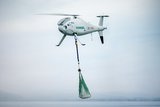US DHS evaluates PTDS for border surveillance
The US Department of Homeland Security (DHS) Customs and Border Protection (CBP) is evaluating the Lockheed Martin Persistent Threat Detection System's (PTDS') ability to provide surveillance for border control. Lockheed Martin is providing operational support for the system.
The PTDS is currently deployed by the US Army as a persistent surveillance asset, providing overwatch for the identification of threats and tracking of insurgents in theatre.
As US troops withdraw from current theatres, Lockheed Martin is supporting the US Army in finding new applications for the systems, such as providing surveillance on the southern US border in the CBP evaluation.
Paula Hartley, vice president of Advanced Products Solutions, Lockheed Martin Mission Systems and Training, said: ‘Lockheed Martin has a long history developing aerostats, and this effort highlights the system's potential and flexibility. As the mission evolves, PTDS is able to adapt its technology for new uses to support our customers and nation.’
PTDS has the capability to provide panoramic day/night surveillance in extremely challenging weather, and remain aloft at high altitudes for long periods. The system can be equipped with multiple sensors, which can be easily and quickly interchanged in order to support different types of CBP missions. PTDS offers a persistent surveillance capability not possible with manned and unmanned aircraft, which encounter surveillance-time limitations dictated by fuel consumption and payload capacity.
Rob Smith, vice president of C4ISR, Lockheed Martin Information Systems and Global Solutions, said: ‘PTDS is a robust system that has proven its worth protecting our forces around the world. Using PTDS to support the CBP mission is an excellent way to leverage and maximise existing capital assets and experienced operators for border protection efforts.’
More from Uncrewed Vehicles
-
Jammer resistant drone designs spark search for countermeasures
The Russia-Ukraine conflict has driven another stage of evolution for drones and the counter measures to defend against them.
-
![L3Harris launches Amorphous software for control of uncrewed platforms]()
L3Harris launches Amorphous software for control of uncrewed platforms
The new Amorphous software is a universal controller that would allow a single operator to control a swarm of “thousands” of uncrewed systems, from drones to underwater platforms.
-
ideaForge unveils new UAVs at Aero India 2025
India UAV supplier ideaForge has launched the Netra 5 and Switch V2 drones at Aero India 2025, boasting of enhanced endurance, AI-driven autonomy and improved operational capabilities.
-
![Shaping the future of defence: What 2025 holds for the global drone market]()
Shaping the future of defence: What 2025 holds for the global drone market
The UAV market is experiencing unprecedented growth, with innovations in technology and battlefield applications driving demand across military sectors. From the battlefields of Ukraine to NATO exercises and beyond, drones are transforming how wars are fought and supported.
-
![Maris-Tech confirms customers signing up for Jupiter Drones codec and AI-powered system]()
Maris-Tech confirms customers signing up for Jupiter Drones codec and AI-powered system
Launched at AUSA in October, the company’s multi-stream video codec is attempting to bring a new lease of life to drone technology through its AI accelerator.
-
![AUSA 2024: Quantum-Systems targets big 2025 with UAS developments]()
AUSA 2024: Quantum-Systems targets big 2025 with UAS developments
Quantum-Systems has been upgrading its UAS family, with new versions of the Vector, Reliant and Twister drones set for release throughout 2025.
























